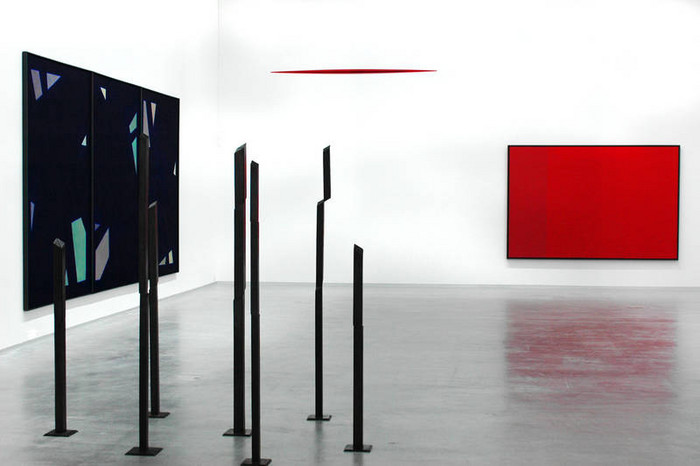Concrete Concepts
08 - 25 May 2008
Concrete Concepts
From the Collection: Art in Berlin
May 8 to May 25, 2008
In 1930, the Dutch artist Theo van Doesburg established that “...nothing is more real than a line, a colour, a surface ...” and so formulated the credo of a painting that focuses entirely on its own basic conditions.
To mark the presentation of the works of this year’s Vattenfall prize-winner Ronald de Bloeme, the Berlinische Galerie is showing non-representational paintings from its collection that aim to focus attention on colour, form and lines. Despite the often simple, easily comprehended constellations of form and colour, unexpected phenomena nonetheless arise when contemplating these works: the flat, striped structure in Andreas Brandt’s paintings appears spatial, for instance. Gerhard Mantz’ red, extremely elongated rhombic pictorial object interacts with the wall, and in Johannes Geccelli’s large-format painting, the areas of colour seem to expand and contract in a way similar to breathing. Of course this process – referred to in a title suggestive of Romantic poetry, Weite Deine Seele (Expand Your Soul) - only happens in the eye of the viewer.
This type of painting placed all its faith in the viewer’s powers of observation and conceived one of the great 20th century utopias; an attempt at democratic art. Younger artists like Ronald de Bloeme counter its enlightening-didactic impulse with an attitude of rather distanced irony.
Artists: Frank Badur, Andreas Brandt, Margarethe Dreher, Johannes Geccelli, Gerhard Mantz, Achim Pahle, Angelik Riemer and Göta Tellesch.
From the Collection: Art in Berlin
May 8 to May 25, 2008
In 1930, the Dutch artist Theo van Doesburg established that “...nothing is more real than a line, a colour, a surface ...” and so formulated the credo of a painting that focuses entirely on its own basic conditions.
To mark the presentation of the works of this year’s Vattenfall prize-winner Ronald de Bloeme, the Berlinische Galerie is showing non-representational paintings from its collection that aim to focus attention on colour, form and lines. Despite the often simple, easily comprehended constellations of form and colour, unexpected phenomena nonetheless arise when contemplating these works: the flat, striped structure in Andreas Brandt’s paintings appears spatial, for instance. Gerhard Mantz’ red, extremely elongated rhombic pictorial object interacts with the wall, and in Johannes Geccelli’s large-format painting, the areas of colour seem to expand and contract in a way similar to breathing. Of course this process – referred to in a title suggestive of Romantic poetry, Weite Deine Seele (Expand Your Soul) - only happens in the eye of the viewer.
This type of painting placed all its faith in the viewer’s powers of observation and conceived one of the great 20th century utopias; an attempt at democratic art. Younger artists like Ronald de Bloeme counter its enlightening-didactic impulse with an attitude of rather distanced irony.
Artists: Frank Badur, Andreas Brandt, Margarethe Dreher, Johannes Geccelli, Gerhard Mantz, Achim Pahle, Angelik Riemer and Göta Tellesch.

